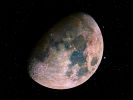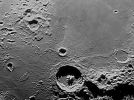|
|

The Moon-05.jpgThe Moon, full frame, from Mars Reconnaissance Orbiter (5)78 visitenessun commento
|
|

The Moon~0.jpgWonderful, wonderful Moon!... (HR)78 visiteDa "NASA - Picture of the Day", del 7 Settembre 2006:"No single exposure can easily capture faint stars along with the subtle colors of the Moon. But this dramatic composite view highlights both.
The mosaic digitally stitches together fifteen carefully exposed HR images of a bright, gibbous Moon and a representative background star field. The fascinating color differences along the Lunar Surface are real, though highly exaggerated, corresponding to regions with different chemical compositions.
And while these color differences are not visible to the eye even with a telescope, Moon watchers can still see a dramatic lunar presentation tonight: a partial eclipse of the Moon will be visible from Europe, Africa, Asia and Australia".
|
|

The_Moon-Aristarchus_Plateau.jpgAristarchus Plateau: the cradle of TLP's75 visiteCaption NASA:"Anchored in the vast lava flows of the Moon's Oceanus Procellarum lies the Aristarchus Plateau. The bright impact crater at the corner of the plateau is Aristarchus, a young crater 42 Km wide and 3 Km deep. Only slightly smaller, lava flooded Herodotus crater is above and to the left.
A valley (or rille) feature likely carved by rapidly flowing lava or a collapsed lava tunnel, Vallis Schroteri begins just to the right of Herodotus and winds across the plateau for about 160 Km, eventually turning toward the top of the picture.
Aristarchus Plateau itself is like a rectangular island about 200 km across, raised up to 2 kilometers or so above the smooth surface of the lunar Ocean of Storms.
Recorded from a backyard observatory in Buffalo, New York, the contrast of light-colored ejecta around Aristarchus with surrounding dark, smooth, lava flooded surfaces suggests more familiar snowy scenes of planet Earth".MareKromium
|
|

The_Moon_-_Rupes_Recta-0.jpgRupes Recta377 visiteRupes Recta is a Linear Fault, or Rille, located on the Moon, in the South-Eastern part of the Mare Nubium, at about 22,1° South Latitude and 7,8° West Longitude.
The name is Latin for "Straight Fault", although this feature is more commonly known as "The Straight Wall". This is the most well-known Escarpment existing on the Moon, and it is also a VERY popular target for amateur astronomers. When the Sun illuminates the feature at an oblique angle, around Day 8 of the Moon's orbit, the Rupes Recta casts a wide shadow that gives it the appearance of a Steep Cliff.
This Fault has a length of approx. 110 Km, a typical width of 2–3 Km and a height of approx. 240–300 mt. Even though the Rupes Recta appears to be a Vertical Cliff on the Lunar Surface, the actual grade of the slope is relatively shallow (low).
To the West of the Rupes, lays the Crater Birt, which is about 10,5 miles in diameter. Also to the West is the Rima Birt Rille. At the Southern End of the Fault, there is a group of Hills often called the "Stag's-Horn Mountains", although this name is not officially recognized by the IAU. To the North-East of the Rupes, the Crater Alpetragius can be found, while to the East lays the Crater Thebit.MareKromium
|
|

The_Moon_-_Rupes_Recta-1.jpgRupes Recta296 visiteMareKromium
|
|

The_Moon_-_Rupes_Recta-2.jpgRupes Recta194 visiteMareKromium
|
|

The_Moon_-_Rupes_Recta-3.jpgRupes Recta203 visiteMareKromium
|
|

Theofilus Crater.jpgTheofilus Crater89 visitenessun commento
|
|

Torricelli Crater-00.jpgTorricelli Crater (1)78 visitenessun commento
|
|

Torricelli Crater-01.jpgTorricelli Crater (2)84 visitenessun commento
|
|

Triesnecker-00.jpgTriesnecker (1)62 visitenessun commento
|
|

Triesnecker-01.jpgTriesnecker (2)69 visitenessun commento
|
|
| 165 immagini su 14 pagina(e) |
 |
 |
 |
 |
 |
9 |  |
 |
 |
 |
|

